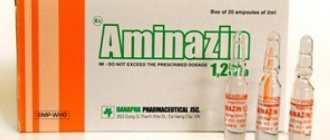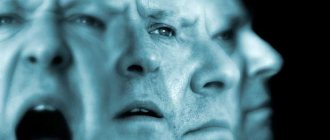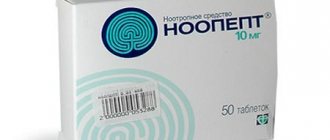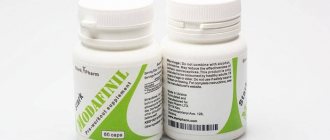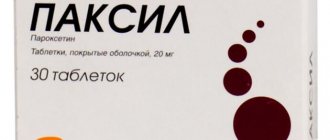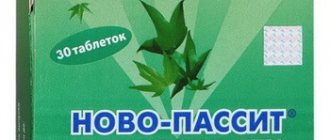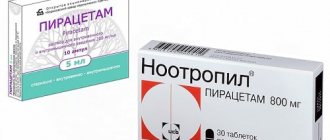Pharmacokinetics and pharmacodynamics
Pantogam is a product based on calcium hopantenate. Produced in tablets and syrup. Pantogam Active is produced in capsules. Due to the active component, the following pharmacological actions are formed:
- the content of GABA (gamma-aminobutyric acid) affects the receptors of cells located in blood vessels and nervous tissue;
- the brain's resistance to oxygen starvation and the effects of toxins increases;
- the functionality of neurons improves, stimulation of anabolic activity;
- slight sedative effect combined with neuronal stimulation;
- decreased motor excitability;
- activation of mental and physical activity.
Due to the mechanism of action, the medicine is often prescribed for alcohol intoxication. It is effective in treating addiction. It is used to enhance the activity of novocaine and sulfonamides.
The pharmacokinetics of the drug are interesting, due to which the load on internal organs is reduced, the number of side effects and contraindications is reduced.
The absorption of the drug occurs in the gastrointestinal tract. It is quickly distributed throughout the internal organs and penetrates the blood-brain barrier into the brain. Metabolism does not occur. Excretion is carried out unchanged through feces and urine.
Release form
The range of Pantogam dosage forms is adapted for use by age groups of patients:
- Syrup for children under three years of age and patients with swallowing disorders, containing 10% calcium hopantenate, in bottles of 50 ml and 100 ml;
- Pantogam for children 3-7 years old in tablets containing 250 mg of calcium salt of hopantenic acid;
- Gelatin capsules Pantogam Active 300 mg for children from three years of age and adults when treated according to an increasing regimen;
- Tablet preparation of hopantenic acid for children over 7 years of age and adults at a dosage of 500 mg.
Indications for use
The medicine has a wide spectrum of action and helps with many disorders. Therefore, it is often used in narcology, neurology, pediatrics, and therapy. The following indications for use are distinguished.
- Impaired cognitive function. They occur due to trauma, neurological disorders, and organic lesions.
- Psychiatric diseases. Used in combination with drugs in the treatment of schizophrenia.
- Extrapyramidal disorders. These are Parkinson's disease, nerve fiber degeneration, Huntington's chorea, myoclonus epilepsy.
- Epilepsy. Despite the complex effect of the drug, its effect is not enough. Therefore, an anticonvulsant is additionally used.
- Psychological deviations. This includes stress, emotional overload, decreased concentration and memory.
- Disorder of the urinary system due to neurological abnormalities. For example, urinary incontinence.
- Developmental delay in children. The medicine is used for disorders of speech, motor functions, and mental activity.
- Cerebral palsy.
- Hyperkinetic type disorder. For example, with attention deficit disorder.
- Neurosis in children, accompanied by tics and stuttering.
Before prescribing the drug, anamnesis is collected. Take into account drug interactions with other drugs. Therefore, the doctor needs to know exactly the patient’s condition.
PANTOGAM (tablets): reviews
Hello, dear visitors and users of the site! Today I really want to tell you about my experience of taking the drug “Pantogam”, which has simply saved my life since 2009. A lot has been suffered and gone through... I couldn’t decide in which thread to write this review, since there is another thread on Pantogam tablets, I decided to write here anyway! I wanted to make the review smaller and less detailed, more delicate or something, because I know that some people really don’t like to read details about diseases, and I myself don’t like it. Alas, in this case you will have to write in detail. It all started in 2009, when I was diagnosed with neurogenic bladder dysfunction (in my case, it’s more accurate to call it overactive bladder), which ...read more
It was caused by very strong, strong, long-term stress and other problems with the nervous system, weakening of the whole body and all the accompanying illnesses, including cystitis (all together left its mark), this unpleasant thing accompanies me to this day, but thanks very much - very good doctors who have been treating me and accompanying me for 8 years in my treatment (nephrologist and neurologist), the doctors prescribed this drug to me in conjunction with a vitamin B complex and other drugs (which I do not take due to side effects), so I most often drink Pantogam alone. And he helps. A little about what neurogenic dysfunction is: (!!!) In no case should it be confused with enuresis, because with it you involuntarily urinate under yourself (sorry for the details.!!!) Neurogenic bladder (less common name - autonomous bladder ) is a syndrome that combines urination disorders and damage to the nerve centers and pathways responsible for urine excretion. There is a violation of bladder control when its activity remains under the control of only the spinal cord. The process of urination ceases to be associated with human consciousness. Symptoms: frequent urge to empty the bladder with a small amount of urine released, or simply a false urge. I’ll also add: There are a LOT of reasons for the development of this disease (mostly it’s very strong long-term stress), I wrote my reasons above, and the rest of the reasons can be found on the Internet. I’ll add a little that this is a rather unpleasant disease that cannot be cured forever, but by taking courses of this drug, it can be temporarily reduced to “no”. Constantly, that is, every 5-15 minutes I want to run to a white friend, the feeling of a full bladder, but in the end there is almost nothing, or, on the contrary, a lot, plus the accompanying unpleasant symptoms and sensations that I probably won’t describe. At night, patients with this diagnosis sleep peacefully and do not wet the bed in their sleep (sorry for the details). Well, maybe they get up 1-2 times for “business”. A full examination was carried out: tests, ultrasound of the kidneys and bladder and everything else - everything was fine, everything was clean. That is, we have neurogenic bladder dysfunction and nothing else. I want to say that a lot of drugs and methods of treatment were tried and they were ineffective, but Pantogam saved me and for 8 years now I have been devoted to it and there is absolutely no addiction, it helps me without fail, its effect lasts a long time. The main thing is not to run into a fake, I always buy at one trusted pharmacy... It was hellishly difficult for me to go out for a walk, even for 10-15 minutes, since I immediately had to run back... With such a diagnosis, no normal work, no study, NO - WHAT - GO... This diagnosis does not allow me to live in peace, but this drug simply saves me. My illness is triggered instantly even because of a small experience, I even try not to think about my illness, but it comes out on its own, and sometimes it happens out of the blue, even it would seem that there was no stress. That is, something is happening there, inside the body, something that I cannot influence in any way, but Pantogam can influence. It’s not for nothing that my doctor constantly prescribes it to me, and he’s not the only one. And now let’s be a little more precise about this drug: Pantogam is available in syrup (for children under 3 years old, as well as in tablets of 250 and 500 mg). In this case, I have 500 mg tablets, when I was a different weight and age, I bought 250 mg tablets. There are 50 tablets in a package. The price for a package of 50 tablets of 500 mg is from 500 to 700 rubles. Someone will think that it is expensive, but in such situations you don’t mind the money, even if you don’t have it. Active substance: hopantenic acid (500 mg), or calcium hopantenate. Pharmacotherapeutic group: Nootropic drug. Pharmacodynamics: The spectrum of action of Pantogam is associated with the presence of gamma-aminobutyric acid in its structure. The mechanism of action is due to the direct influence of Pantogam® on the GABAB receptor-channel complex. The drug has a nootropic and anticonvulsant effect. Pantogam increases the brain's resistance to hypoxia and the effects of toxic substances, stimulates anabolic processes in neurons, combines a moderate sedative effect with a mild stimulating effect, reduces motor excitability, and activates mental and physical performance. Improves GABA metabolism during chronic alcohol intoxication and after ethanol withdrawal. It is capable of inhibiting acetylation reactions involved in the mechanisms of inactivation of procaine (novocaine) and sulfonamides, thereby prolonging the action of the latter. Causes inhibition of the pathologically increased bladder reflex and detrusor tone. Indications and dosage: there are many indications and different dosages for everyone, so I will simply attach a photo with instructions (there will be dosages for different cases, and I will write the indications here to make it more convenient for you.) INDICATIONS: - cognitive impairment in organic brain lesions (in including the consequences of neuroinfections and traumatic brain injuries) and neurotic disorders; - schizophrenia with organic cerebral insufficiency; - cerebrovascular insufficiency caused by atherosclerotic changes in cerebral vessels; - extrapyramidal disorders (including myoclonus epilepsy, Huntington's chorea, hepatolenticular degeneration, Parkinson's disease), as well as for the treatment and prevention of extrapyramidal syndrome (hyperkinetic and akinetic) caused by taking antipsychotics; - epilepsy with slowing of mental processes in complex therapy with anticonvulsants; - psychoemotional overload, decreased mental and physical performance (to improve concentration and memory); - neurogenic urination disorders (pollakiuria, urgency, imperative urinary incontinence, enuresis); - children with perinatal encephalopathy from the first days of life; - various forms of cerebral palsy; - mental retardation of varying degrees, including . with behavioral disorders; - psychological status disorders in children in the form of general mental retardation, specific speech disorders, motor functions and their combinations, the formation of school skills (reading, writing, counting, etc.); - hyperkinetic disorders, incl. h. attention deficit hyperactivity syndrome; - neurosis-like conditions (with stuttering, predominantly clonic form, tics, inorganic encopresis and enuresis). CONTRAINDICATIONS: (There are very few): Hypersensitivity, acute severe kidney disease, pregnancy, lactation and children under 3 years of age (for tablets). ANALOGUES Pantogam: Calcium hopanthenate, Pantocalcin (I’m not at all sure about the effectiveness of the first, but the second costs much more than Pantogam and I haven’t tried it, I can’t say anything. Still, I trust Pantogam, it’s an original drug). When I first saw Pantogam’s readings, I almost fainted, but in fact it is a very good and time-tested nootropic drug! I take this drug in courses 2-3 times a year for 1.5-2 months. Even if everything has passed, I don’t stop drinking, but continue the course, or even if the dysfunction does not make itself felt, but the time has come to start a new course, I drink. It's better to be overly safe than under-safe =) The dosage is prescribed by your doctor. Personally, I drink 1500 mg per day. That is, 1000 mg (2 tablets of 500 mg) in the morning, 15-30 minutes after meals and 500 mg in the afternoon, again 15-30 minutes after meals. Previously, I crushed them (pushed them), diluted them with water and washed them down, but now I don’t do that, but drink the whole tablets. It is not recommended to take pills after 17:00 due to the stimulating effect on the nervous system, but if you go to bed late, then it’s okay if you take it even at 18:00. Already on the 14-17th day of admission it becomes easier: the intervals increase from 5 minutes to 45, and then to two hours, then to three, then to four!!! THIS IS JUST A MIRACLE!!! And the effect lasts a long time, about 4 months. In addition, it has a beneficial effect on the central nervous system, improves memory, increases performance, increases the brain’s resistance to hypoxia, toxic substances, etc., which I wrote about above. In addition to the main treatment, it is very important for neurogenic dysfunction to maintain thermal rest: that is, not to get too cold, not to overheat, and as many positive emotions as possible and not to be nervous, which is almost unrealistic in my life, hippotherapy helps me a lot, go somewhere and get distracted, or go out into nature, go to a museum (when this is already possible due to this disease). I haven’t noticed any side effects on myself, on the contrary, Pantogam is good and easy, despite the fact that I generally have a hard time accepting various nootropics and similar drugs, it is even prescribed to children for delayed speech development and more. My review is not a call to take this drug, I just talked about how it helped me with my diagnosis and still helps to this day! Before taking, be sure to consult with your doctor! I hope that Pantogam will help you too! If it were possible, I would give this drug not 5 stars, but 555... This is my savior, I don’t know how I would live without it... Thank you, Pantogam... I wish you health and all the best!
Hello, dear visitors and users of the site! Today I really want to tell you about my experience of taking the drug “Pantogam”, which has simply saved my life since 2009. A lot has been suffered and gone through... I couldn’t decide in which thread to write this review, since there is another thread on Pantogam tablets, I decided to write here anyway! I wanted to make the review smaller and less detailed, more delicate or something, because I know that some people really don’t like to read details about diseases, and I myself don’t like it. Alas, in this case you will have to write in detail. It all started in 2009, when I was diagnosed with neurogenic bladder dysfunction (in my case, it would be more accurate to call it an overactive bladder), which was caused by very strong, long-term stress and other problems with the nervous system, weakening of the whole body and all the accompanying illnesses, including including cystitis (all together left its mark), this unpleasant thing accompanies me to this day, but thanks to the very, very good doctors who treat me and accompany me for 8 years in my treatment (nephrologist and neurologist), doctors This drug was prescribed in conjunction with a vitamin B complex and other drugs (which I do not take due to side effects), so I most often take Pantogam alone. And he helps. A little about what neurogenic dysfunction is: (!!!) In no case should it be confused with enuresis, because with it you involuntarily urinate under yourself (sorry for the details.!!!) Neurogenic bladder (less common name - autonomous bladder ) is a syndrome that combines urination disorders and damage to the nerve centers and pathways responsible for urine excretion. There is a violation of bladder control when its activity remains under the control of only the spinal cord. The process of urination ceases to be associated with human consciousness. Symptoms: frequent urge to empty the bladder with a small amount of urine released, or simply a false urge. I’ll also add: There are a LOT of reasons for the development of this disease (mostly it’s very strong long-term stress), I wrote my reasons above, and the rest of the reasons can be found on the Internet. I’ll add a little that this is a rather unpleasant disease that cannot be cured forever, but by taking courses of this drug, it can be temporarily reduced to “no”. Constantly, that is, every 5-15 minutes I want to run to a white friend, the feeling of a full bladder, but in the end there is almost nothing, or, on the contrary, a lot, plus the accompanying unpleasant symptoms and sensations that I probably won’t describe. At night, patients with this diagnosis sleep peacefully and do not wet the bed in their sleep (sorry for the details). Well, maybe they get up 1-2 times for “business”. A full examination was carried out: tests, ultrasound of the kidneys and bladder and everything else - everything was fine, everything was clean. That is, we have neurogenic bladder dysfunction and nothing else. I want to say that a lot of drugs and methods of treatment were tried and they were ineffective, but Pantogam saved me and for 8 years now I have been devoted to it and there is absolutely no addiction, it helps me without fail, its effect lasts a long time. The main thing is not to run into a fake, I always buy at one trusted pharmacy... It was hellishly difficult for me to go out for a walk, even for 10-15 minutes, since I immediately had to run back... With such a diagnosis, no normal work, no study, NO - WHAT - GO... This diagnosis does not allow me to live in peace, but this drug simply saves me. My illness is triggered instantly even because of a small experience, I even try not to think about my illness, but it comes out on its own, and sometimes it happens out of the blue, even it would seem that there was no stress. That is, something is happening there, inside the body, something that I cannot influence in any way, but Pantogam can influence. It’s not for nothing that my doctor constantly prescribes it to me, and he’s not the only one. And now let’s be a little more precise about this drug: Pantogam is available in syrup (for children under 3 years old, as well as in tablets of 250 and 500 mg). In this case, I have 500 mg tablets, when I was a different weight and age, I bought 250 mg tablets. There are 50 tablets in a package. The price for a package of 50 tablets of 500 mg is from 500 to 700 rubles. Someone will think that it is expensive, but in such situations you don’t mind the money, even if you don’t have it. Active substance: hopantenic acid (500 mg), or calcium hopantenate. Pharmacotherapeutic group: Nootropic drug. Pharmacodynamics: The spectrum of action of Pantogam is associated with the presence of gamma-aminobutyric acid in its structure. The mechanism of action is due to the direct influence of Pantogam® on the GABAB receptor-channel complex. The drug has a nootropic and anticonvulsant effect. Pantogam increases the brain's resistance to hypoxia and the effects of toxic substances, stimulates anabolic processes in neurons, combines a moderate sedative effect with a mild stimulating effect, reduces motor excitability, and activates mental and physical performance. Improves GABA metabolism during chronic alcohol intoxication and after ethanol withdrawal. It is capable of inhibiting acetylation reactions involved in the mechanisms of inactivation of procaine (novocaine) and sulfonamides, thereby prolonging the action of the latter. Causes inhibition of the pathologically increased bladder reflex and detrusor tone. Indications and dosage: there are many indications and different dosages for everyone, so I will simply attach a photo with instructions (there will be dosages for different cases, and I will write the indications here to make it more convenient for you.) INDICATIONS: - cognitive impairment in organic brain lesions (in including the consequences of neuroinfections and traumatic brain injuries) and neurotic disorders; - schizophrenia with organic cerebral insufficiency; - cerebrovascular insufficiency caused by atherosclerotic changes in cerebral vessels; - extrapyramidal disorders (including myoclonus epilepsy, Huntington's chorea, hepatolenticular degeneration, Parkinson's disease), as well as for the treatment and prevention of extrapyramidal syndrome (hyperkinetic and akinetic) caused by taking antipsychotics; - epilepsy with slowing of mental processes in complex therapy with anticonvulsants; - psychoemotional overload, decreased mental and physical performance (to improve concentration and memory); - neurogenic urination disorders (pollakiuria, urgency, imperative urinary incontinence, enuresis); - children with perinatal encephalopathy from the first days of life; - various forms of cerebral palsy; - mental retardation of varying degrees, including . with behavioral disorders; - psychological status disorders in children in the form of general mental retardation, specific speech disorders, motor functions and their combinations, the formation of school skills (reading, writing, counting, etc.); - hyperkinetic disorders, incl. h. attention deficit hyperactivity syndrome; - neurosis-like conditions (with stuttering, predominantly clonic form, tics, inorganic encopresis and enuresis). CONTRAINDICATIONS: (There are very few): Hypersensitivity, acute severe kidney disease, pregnancy, lactation and children under 3 years of age (for tablets). ANALOGUES Pantogam: Calcium hopanthenate, Pantocalcin (I’m not at all sure about the effectiveness of the first, but the second costs much more than Pantogam and I haven’t tried it, I can’t say anything. Still, I trust Pantogam, it’s an original drug). When I first saw Pantogam’s readings, I almost fainted, but in fact it is a very good and time-tested nootropic drug! I take this drug in courses 2-3 times a year for 1.5-2 months. Even if everything has passed, I don’t stop drinking, but continue the course, or even if the dysfunction does not make itself felt, but the time has come to start a new course, I drink. It's better to be overly safe than under-safe =) The dosage is prescribed by your doctor. Personally, I drink 1500 mg per day. That is, 1000 mg (2 tablets of 500 mg) in the morning, 15-30 minutes after meals and 500 mg in the afternoon, again 15-30 minutes after meals. Previously, I crushed them (pushed them), diluted them with water and washed them down, but now I don’t do that, but drink the whole tablets. It is not recommended to take pills after 17:00 due to the stimulating effect on the nervous system, but if you go to bed late, then it’s okay if you take it even at 18:00. Already on the 14-17th day of admission it becomes easier: the intervals increase from 5 minutes to 45, and then to two hours, then to three, then to four!!! THIS IS JUST A MIRACLE!!! And the effect lasts a long time, about 4 months. In addition, it has a beneficial effect on the central nervous system, improves memory, increases performance, increases the brain’s resistance to hypoxia, toxic substances, etc., which I wrote about above. In addition to the main treatment, it is very important for neurogenic dysfunction to maintain thermal rest: that is, not to get too cold, not to overheat, and as many positive emotions as possible and not to be nervous, which is almost unrealistic in my life, hippotherapy helps me a lot, go somewhere and get distracted, or go out into nature, go to a museum (when this is already possible due to this disease). I haven’t noticed any side effects on myself, on the contrary, Pantogam is good and easy, despite the fact that I generally have a hard time accepting various nootropics and similar drugs, it is even prescribed to children for delayed speech development and more. My review is not a call to take this drug, I just talked about how it helped me with my diagnosis and still helps to this day! Before taking, be sure to consult with your doctor! I hope that Pantogam will help you too! If it were possible, I would give this drug not 5 stars, but 555... This is my savior, I don’t know how I would live without it... Thank you, Pantogam... I wish you health and all the best!
Rating: 5 5
Source:
irecommend.ru
How to take the drug for children
The medicine is approved for use by children. It is important to choose the right dosage. But when taking pills, you need to consider the following principles:
- take 30 minutes before meals;
- syrup is used for children under 3 years of age, tablets for children older than this age;
- take only in the morning or afternoon.
A preliminary examination is carried out. Find out indications and contraindications. The diagnosis for which therapy is started is taken into account:
- extrapyramidal disorders - no more than 0.5 g up to 4 times a day with a course of treatment of up to 3 months;
- epilepsy of any origin - up to 0.5 g 4 times a day with a course of treatment of up to 6 months;
- urination disorder - up to 0.5 g 3 times a day with a course of 1-3 months;
- developmental delay - up to 0.5 g 3 times a day with a course of treatment of 2 months;
- hyperactivity - up to 1 g 2 times a day for up to 4 months;
- neuroses - up to 0.5 g 6 times a day for up to 4 months.
The smallest dosage recommended for children is 0.25 g. It is best taken if the disorder is minor and requires a short course of treatment. The worse the patient’s condition, the greater the concentration of the drug required in 1 day. After completing the course, they are re-examined and tested.
"Pantogam": description of the drug
The drug "Pantogam" belongs to the nootropics. Such drugs have a specific positive effect on the analytical and synthetic activity of the brain. They improve the functioning of the cerebral cortex, stimulate cognitive functions, learning, and memory. Nootropic drugs increase the resistance of brain cells to extreme overloads and lack of oxygen in nerve tissues. The drugs are also able to reduce focal neurological symptoms and improve cortico-subcortical connections.
Pantogam is also a psychostimulant. This group includes drugs that increase mental and physical activity, the ability to accelerate responses to external stimuli. Psychotropic drugs help improve mood, relieve fatigue, and temporarily reduce the need for rest/sleep.
Pantogam contains hopantenic acid, which has the above-mentioned pharmacological properties. The drug is available in two dosage forms - tablets and syrup. They have the same active pharmaceutical substance, but the composition of the excipients is slightly different.
Tablets can contain 250 or 500 mg of active ingredient. In addition they include:
- Cellulose ether and methanol – 0.8/1.6 mg.
- Calcium stearate – 3.1/6.2 mg.
- Magnesium bicarbonate – 46.8/93.6 mg.
- Talc – 9.3/18 mg.
Tablets are produced in 10 pieces in a cardboard box or in 50 pieces. in a glass jar.
The syrup contains 10 g of active substance per 100 ml. Excipients:
- Glycerol – 25.8 g.
- Sorbitol – 15 g.
- Citric acid – 0.1 g.
- Sodium benzoate – 0.1 g.
- Aspartame (sweetener) – 0.05 g.
- Food flavoring “Cherry 667” – 0.07 g.
The syrup is sold in glass bottles of 100 mg with a dosage spoon.
Dosage for adults
If a person is over 18 years old, the amount of the drug is very different from children. The range of applications for which the medicine can be used has been expanded. The following doses are recommended:
- cognitive disorders - 0.25 g 4 times a day;
- extrapyramidal disorders - 0.5 g or more 3 times a day for up to 4 months;
- epilepsy - up to 1 g 3 times a day with a course of treatment of up to 6 months;
- psycho-emotional overload - up to 0.25 G 3 times a day;
- urinary disturbance - up to 1 g 3 times a day.
The minimum dosage for adults is 0.25 g. If you count it over 1 day, the size increases to 1.5 g. This concentration is suitable for psycho-emotional overload and impaired cognitive functions. For more severe lesions, the amount of the substance is increased.
Because there are relatively few side effects, the drug is often prescribed to adult patients with severe disorders. When using the product, you will need to be tested again. For example, a general clinical examination of blood and urine, examination by a neurologist, MRI. The medicine is often prescribed in combination with other drugs. Please note that when using different types of substances at the same time, you should wait an interval of 15-30 minutes to reduce the risk of cross-reaction.
Comparison of ease of use of Pantogam and Nootropil
This includes dose selection taking into account various conditions and frequency of doses. At the same time, it is important not to forget about the release form of the drug; it is also important to take it into account when making an assessment.
The ease of use of Pantogam is approximately the same as Nootropil. However, they are not convenient enough to use.
The drug ratings were compiled by experienced pharmacists who studied international research. The report is generated automatically.
Last update date: 2019-09-19 05:59:38
Side effects and contraindications
Since the drug does not accumulate in the body and is completely eliminated from it, the number of side effects is sharply reduced. They occur infrequently and disappear quickly when the drug is eliminated. The following negative actions are identified:
- allergic manifestations on the conjunctiva of the eyes, skin;
- headache, dizziness, increased excitability, tinnitus;
- mood changes, sleep disturbance, lethargy, malaise.
If any type of side effects occur, the drug should be discontinued immediately. If they are minor, the dosage may be reduced. The following contraindications for use are identified:
- pregnancy, lactation;
- for tablets - children under 3 years of age;
- severe kidney damage;
- individual intolerance to components.
The drug should not be used in case of severe kidney damage, since the substance is completely excreted in the urine. This can damage the glomerular apparatus and disrupt the filtration system. Therefore, the patient’s well-being will worsen. Since there are not enough clinical trials in pregnant and breastfeeding women, the medicine is not recommended. But no exact contraindications have been identified during this period.
Comparison of addiction between Pantogam and Nootropil
Like safety, addiction also involves many factors that must be considered when evaluating a drug.
So, the totality of the values of such parameters as “o syndrome” in Pantogam is quite similar to the similar values in Nootropil. Withdrawal syndrome is a pathological condition that occurs after the cessation of intake of addictive or dependent substances into the body. And resistance is understood as initial immunity to a drug; in this it differs from addiction, when immunity to a drug develops over a certain period of time. The presence of resistance can only be stated if an attempt has been made to increase the dose of the drug to the maximum possible. At the same time, Pantogam has a fairly small value of “syndrome”, however, the same as Nootropil.
special instructions
When using a short course of treatment, the medicine can be used with other nootropic drugs. If treatment is carried out for more than 1 month, it is better to use only 1 drug. The risk of sudden side effects will increase.
When using Pantogam, you need to be careful about your well-being in the first 2 weeks of the course. This is due to the fact that concentration may decrease, so it is better to stop driving a vehicle. If this effect does not occur in the future, the ban on driving a car or operating heavy machinery is lifted.
The medicine can cause an overdose, which will cause a significant deterioration in the patient’s well-being.
Therefore, it is prohibited to use the product not according to the instructions from the doctor. In case of overdose, sleep disturbance is noted. The person may experience insomnia or drowsiness. There is noise in the ears and headache.
In this case, it is recommended to drink activated carbon and consult a doctor. If your health continues to deteriorate, he will prescribe gastric lavage and symptomatic therapy.
Price
Since Pantogam is prescribed for a course of one to several months, many patients are concerned about the cost of the drug. The price for a package of 500 mg tablets in pharmacies starts from 600 rubles. If you are purchasing medicine for a child, it would be more advisable to buy Pantogam with a dosage of 250 mg, since it does not need to be divided into smaller doses. The cost of a 250 mg package is approximately 385 rubles. If your doctor prescribed you “Pantogam” in syrup form, then a 100 ml package will cost you 364 rubles.
Interaction with other drugs
During a general examination and medical history, the doctor carefully finds out what medications the patient uses. This is especially important since Pantogam affects other medicines. All drugs that penetrate the blood-brain barrier into the brain are taken into account. Detects the following drug interactions:
- Phenobarbital, Carbamazepine, neuroleptics - strong anticonvulsant effect;
- barbiturates - increase the duration of action;
- Glycine, etidronic acid - enhances the effect of Pantogam;
- local anesthetics (lidocaine, novocaine) - enhanced anesthetic effect.
If there is no compatibility, only one of the remedies that will be most important to the patient is used. When cross-reaction occurs, one of the drugs may cause side effects. In this case, the medications are discontinued and the patient’s well-being is monitored. Then the most important drug is re-prescribed for use, gradually increasing the dosage so that the therapeutic effect occurs.
It is important that Pantogam reduces the side effects of Phenobarbital. This is convenient for patients who cannot take other medications besides it. Therefore, Pantogam is often combined with Phenobarbital, even in the absence of urgent need.
pharmachologic effect
Hopanthenic acid is classified as a group of nootropics based on the principle of its effect on the human body. The mechanism of pharmacological action is based on direct stimulation of γ-aminobutyrate receptors as part of transmembrane complexes, which leads to postsynaptic inhibition of neurons.
Clinically, taking Pantogam is manifested by an increase in the tolerance of nervous tissue to oxygen deficiency and intoxication. A mild sedative and moderate anticonvulsant effect of Pantogam is also noted, for which the drug is prescribed as part of the complex treatment of alcohol dependence, epilepsy and organic lesions of the nervous system.
In patients using Pantogam according to the instructions, one can expect an increase in physical performance and intellectual functions, a decrease in spastic reactions from the smooth muscles of the urinary and gall bladders.
The peak concentration of pantogam in the blood is reached on the second day of administration. The drug is able to penetrate the blood-brain barrier and the placenta. Hopantenic acid is excreted 67.5% by the kidneys, up to 29% is removed with feces, the rest of the substance is excreted through the sweat and mammary glands.
Analogues and substitutes
If the patient has individual intolerance, it is recommended to select an analogue, which also has a nootropic and anticonvulsant effect, but the patient tolerates it better. If there are no contraindications for taking Pantogam, substitutes with a lower cost are selected. Its average price is 600-650 rubles. Data on analogues are presented in the table.
| A drug | Active ingredients | Manufacturer | Price |
| Pantocalcin | Calcium hopantenate | Valenta pharmaceuticals, Russia | 400-450 |
| Phenibut | Aminophenylbutyric acid | Obninsk Chemical and Pharmaceutical Company, Russia | 50-500 |
| Picamilon | Nicotine gamma aminobutyric acid | Pharmstandard Ufa Vitamin Plant, Russia | 80-150 |
| Mexidol | Ethylmethylhydroxypyridine succinate | Pharmasoft, Russia | 240-640 |
| Gopantham | Calcium hopantenate | Altaivitamins, Russia | 350-500 |
Since Pantogam penetrates the blood-brain barrier, affecting the brain, it is best to use it on the recommendation of a neurologist. When a replacement is made with another active substance, they undergo a preliminary examination. This is done in case of sudden onset of side effects that significantly worsen the patient’s well-being. When prescribed by a doctor, this risk is reduced.
Comparison of the safety of Pantogam and Nootropil
The safety of a drug includes many factors.
At the same time, in Pantogam it is quite similar to Nootropil. It is important where the drug is metabolized: drugs are excreted from the body either unchanged or in the form of products of their biochemical transformations. Metabolism occurs spontaneously, but most often involves major organs such as the liver, kidneys, lungs, skin, brain and others. When assessing the metabolism of Pantogam, as well as Nootropil, we look at which organ is the metabolizing organ and how critical the effect on it is.
The risk-benefit ratio is when the prescription of a drug is undesirable, but justified under certain conditions and circumstances, with the obligatory observance of caution in use. At the same time, Pantogam does not have any risks when used, just like Nootropil.
Also, when calculating safety, it is taken into account whether only allergic reactions occur or possible dysfunction of the main organs. In other matters, as well as the reversibility of the consequences of using Pantogam and Nootropil.
What is the best way to choose an analogue for children?
The choice of analogue for children is especially important. It is better not to make a replacement on your own, since parents do not always take into account indications and contraindications, relying only on cost. If the current active ingredient is suitable, use products containing an identical active ingredient, that is, calcium hopanthenate. In this case, Pantocalcin and Gopantam are suitable. The dosage will remain identical, but parents will spend less money on treating their child.
When choosing a medicine with another main active ingredient, you must carefully read the instructions for use. Not all of them are approved for use by children. Pantogam differs in that it is produced in syrup, so it can be consumed even by infants.
Some analogues have not undergone sufficient clinical trials (Mexidol) for children, so it is recommended to choose other medications that are fully approved by doctors.
If analogues are used in tablet form, they can be prescribed only from 3 years of age. But for each use of the drug in this case, you will need to undergo a full examination and collect an anamnesis.
Phenibut and Pantogam - which is better to choose?
Nootropic drugs are being used more and more often. They are prescribed for various disorders of the nervous system. The question becomes relevant, which nootropic is safer and more effective - Pantogam or Phenibut.
Nootropic substances affect the integrative functions of the brain, improve memory, facilitate learning processes, and stimulate intellectual work.
What are the similarities between the drugs?
- They belong to the same group of nootropic medications.
- Both medications can improve memory and increase intelligence.
- Helps with attention problems.
- Increases performance.
- Helps you relax after emotional overload.
How are medications different?
- Phenibut is an imported Latvian product, Pantogam is a domestically developed drug.
- Cost difference . Pantogam in a dosage of 250 mg, 50 tablets costs 360 rubles, Phenibut in the same dosage, but in the amount of 20 tablets costs 400 rubles.
- Various active ingredients.
- Phenibut, in addition to its nootropic functions, has a tranquilizing and psychostimulating effect. Pantogam does not have such effects.
- Phenibut is contraindicated in children under 2 years of age; the domestic medicine is prescribed from birth.
- The list of indications varies slightly.
The imported drug effectively reduces anxiety, helps cope with fears, and normalizes sleep quality. Pantogam does not reveal such properties. - Phenibut relieves dizziness, fights Meniere's disease and other diseases of the vestibular system. Helps with motion sickness. The domestic analogue is powerless in these cases.
- When taking Phenibut, brain activity is maintained. The domestic analogue stimulates certain areas of the brain.
Which pills will be better?
Phenibut eliminates high anxiety in a short time, helps get rid of constant feelings of fear and anxiety, and improves the process of falling asleep. The medication is also recommended for the prevention of dizziness, Meniere's disease, as well as various pathologies of the vestibular apparatus.
The domestic drug is more suitable for treating patients with epileptic seizures, mental disorders, and schizophrenia. Shows anticonvulsant effect, relieves lethargy.
Pantogam is safer for children than the imported drug. Phenibut is prescribed to children for neuroses, cerebral palsy, mental retardation, stuttering, and tics.
To summarize, it can be noted that Pantogam and Phenibut are different drugs. It is difficult to conclude which one is better, since they have different effects on the body. It is unknown how the drug will affect humans.
Nootropic drugs must be taken strictly as prescribed by the treating doctor . Therapy should be completed gradually, reducing the dose.
Source: https://vchemraznica.ru/fenibut-i-pantogam-chto-luchshe-vybrat/



